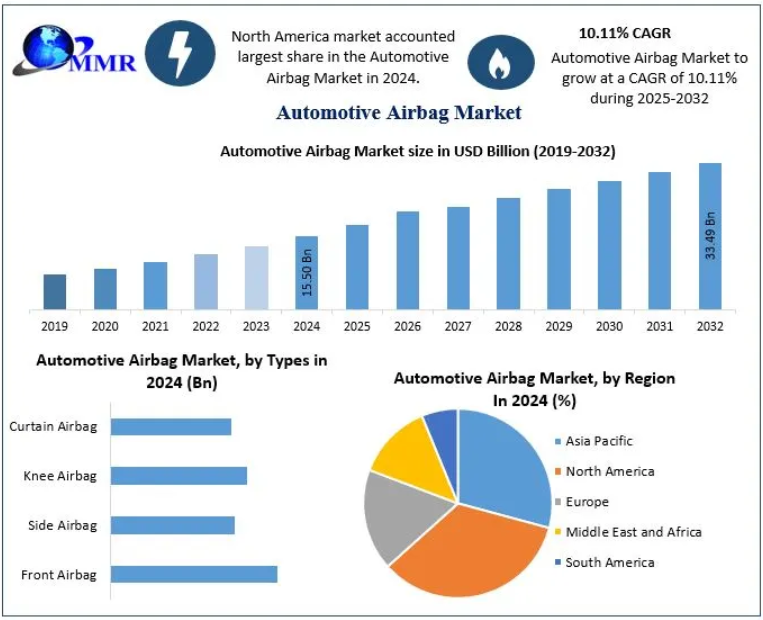Automotive Airbag Market Research Report: Global Outlook to 2032

Global Automotive Airbag Market Poised to Surpass USD 33.49 Billion by 2032, Driven by Safety Innovations and Regulatory Mandates
The Global Automotive Airbag Market, valued at USD 15.50 billion in 2024, is expected to surge at a CAGR of 10.11% from 2025 to 2032, reaching an estimated USD 33.49 billion by 2032. This remarkable growth is driven by increasing consumer awareness around vehicle safety, rising road accident fatalities, regulatory mandates across nations, and rapid advancements in airbag technology.
Market Definition and Overview
Automotive airbags are crucial passive safety components designed to protect passengers during collisions by reducing the risk of injury. A typical airbag system includes an airbag module, sensor systems, hood lift limiters, and inflators. The growing emphasis on minimizing fatalities and serious injuries during road accidents is making airbags a standard safety feature globally, particularly in passenger cars and commercial vehicles.
For in-depth information on this study, visit the following link:https://www.maximizemarketresearch.com/request-sample/11119/
Market Growth Drivers and Opportunities
1. Regulatory Push for Mandatory Safety
Countries worldwide are mandating airbag installations to curb accident-related fatalities. In India, the Ministry of Road Transport and Highways (MoRTH) announced the mandatory inclusion of dual front airbags in all new vehicles from April 2021 onward. Similarly, the U.S. has robust regulatory frameworks that have made airbags a non-negotiable feature in automobiles.
2. Increasing Automotive Production and Demand
With the rising demand for passenger vehicles, particularly in emerging economies such as India and Southeast Asian nations, the installation of advanced safety systems is becoming a key differentiator. The growing middle class and urbanization have fueled automotive sales, which directly drive airbag demand.
3. Technological Advancements in Airbag Systems
The development of sensor-based airbag systems, knee airbags, and rear-seat airbags (as seen in premium models like the Mercedes S-Class) are game-changers. These innovations enhance overall occupant protection and are expected to see increased adoption across various vehicle categories.
4. Strategic Collaborations and R&D Initiatives
Collaborations between automakers and component manufacturers are ramping up. For instance, Honda’s partnership with Autoliv focuses on minimizing airbag-induced injuries and improving deployment efficiency. Companies are heavily investing in R&D to deliver lighter, faster-deploying, and more effective airbags.
Segmentation Analysis
By Vehicle Type
- Passenger Cars (PC) dominated the market in 2024 and are expected to continue leading due to increased demand and regulatory norms.
- Light Commercial Vehicles (LCVs) and Trucks are increasingly being fitted with curtain and side airbags, reflecting a broader commitment to road safety across all vehicle segments.
By Type
- Front Airbags remain foundational to safety systems.
- Curtain Airbags are experiencing the fastest growth owing to their head and side impact protection.
- Side Airbags and Knee Airbags are gaining momentum as OEMs focus on comprehensive protection solutions.
By Module
- Inflators/Gas Generators and Airbags are core components, with advancements focused on minimizing size and improving deployment accuracy.
To access more details regarding this research, visit the following webpage:https://www.maximizemarketresearch.com/request-sample/11119/
Regional Insights
United States
The U.S. leads the global automotive airbag market with a projected CAGR of 25.7%. Growth is driven by large-scale passenger vehicle production, robust government regulations, and the presence of key OEMs and Tier-1 suppliers.
Europe
Technological advancement and electric vehicle adoption are propelling the airbag market across Germany, UK, and France. The European Commission's funding for airbag valve technologies underscores the region’s commitment to safety innovations.
Asia Pacific
India is emerging as a pivotal market. Passenger vehicle sales rose by 11.4% in 2024, with production surpassing 22.65 million units, as reported by SIAM. China, South Korea, and Japan are also experiencing robust growth driven by local OEMs, rising safety awareness, and government mandates.
Germany
Despite a brief production dip during the pandemic, Germany’s automotive sector has rebounded strongly. As passenger vehicle manufacturing recovers, demand for advanced airbag systems is rising, supported by stringent EU safety norms.
Competitive Landscape
Key market players are focusing on technological innovation, strategic collaborations, and geographic expansion to maintain competitive advantage. Prominent players include:
- Autoliv Inc.
- Hyundai Mobis
- ARC Automotive, Inc.
- Ashimori Industry Co., Ltd.
- Daicel Chemical Industries Ltd.
- ABC Group
- Hanwha Group
- Furukawa Electric
- China National Bluster Corporation
- Calsonic Kansei
- Am-Safe Commercial Products
- Hyosung Corporation
These players are investing in sustainable manufacturing, digital simulations for crash testing, and lightweight materials to improve safety and cost-effectiveness.
Conclusion
The global automotive airbag market is at a transformative stage, powered by rising safety consciousness, robust government mandates, and technological innovations. Emerging economies, especially in Asia Pacific, are expected to be key growth drivers, backed by growing automotive production and policy changes.
With evolving safety needs and the continuous evolution of smart mobility, airbag manufacturers and OEMs have ample opportunities to invest in R&D, develop smarter and safer solutions, and strengthen their market presence.
As automakers align with regulatory demands and consumer expectations, the automotive airbag industry is set to remain a vital component of global automotive safety for years to come.
